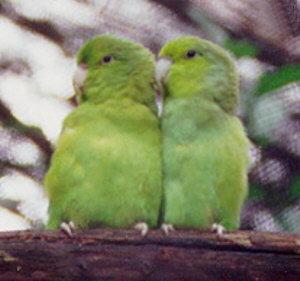Parrotlet - Maxican
Scientific Name: Forpus cyanopygius cyanopygius
Sat, 19th July, 2025 - 2:33 am GMT
Sponsor Ads:

Alternative Name
Scientific Name: Forpus cyanopygius cyanopygiusBasic Info
Mexican Parrotlets grow to around five and a half inches, and their plumage is predominantly green in color. Males have a yellow wash over their heads and underparts, although some have blue-washed underparts. The rump and lower back as well as the axillary feathers and under-wing coverts are bright turquoise! The rest of the wing is blue colored. Male Mexican Parrotlets have bluish-green undersides of flight feathers and tails. Like the females, their irises are brown, their legs are grey, and their bills are horn-colored. Female Mexican Parrotlets have yellowish- green feathering where males have blue colors. Where some males have bluish under carriages, females have more yellow.
Health
Mexican Parrotlets will become sick if fed a vitamin supplement in addition to a pellet diet. Many parrotlets will not eat from hooded or covered dishes. Be sure to place perches in their cages in places where they birds' tail feathers will not dip into their food or water. Breeding Mexican Parrotlets who are breeding should be fed a calcium supplement and if they are on a pellet diet, should be supplemented with seeds. In captivity, Mexican Parrotlets can breed in a colony. They will only breed in spring and summer, and Mexican Parrotlets never have more than one clutch a year. Sometimes they will only breed every other year. Immature Mexican Parrotlets are similar in coloration to adults, but males have green mixed in with their blue feathers.Habitat
N/ABehavior
Sadly enough, the cheerful, colorful Mexican Parrotlet is becoming more and more rare in the wild. Consequently, these parrotlets need the aid of aviculturalists, as captive-breeding programs may be the only hope the species has for survival. Mexican Parrotlets are sweet, playful little animals. Unlike many parrotlets who are relatively territorial and jealous, Mexican Parrotlets are very laid-back. They have easy-going temperaments and, in a large enough aviary, may be kept in colonies. Mexican Parrotlets should be fed a pellet diet or a basic seed mix, supplemented with plenty of fresh fruits, greenfood, vegetables, and of course, they need fresh water at all times. If your parrotlet is eating seeds rather than pellets, supplement their diet with vitamins. Provide a cuttlebone for your parrotlet. They will also love people-carbohydrate food like bread or pasta. Be careful when taking your parrotlet outside; even Mexican Parrotlets with clipped wings may be able to fly! Mexican Parrotlets need lots of toys, and adore swings and rope or anything they can chew on! They are quite strong, so be sure the toys will stand up to their hard beaks. Parrotlets bond strongly with the person who spends the most time with them, especially during the time when they are between six and 12 weeks old. Even older Mexican Parrotlets will bond well with their handlers, requiring lots of affection and playtime!Origin
MexicoHistory
Mexican Parrotlets are native to Mexico, of course! Their native habitats are quickly being lost, and possibly the only hope Mexican Parrotlets have of survival is captive breeding. Unfortunately, very few are bred in captivity and the International Parrot Society has set up a program to encourage the propagation of these birds.Common Foods
N/ASponsor Ads:
A thorough software professional is one who when his wife yells at him "goto hell", worries more about the goto.
Parrotlet - Maxican
Coded by: BGID® | ALL RIGHTS RESERVED Copyright © 2000-2025
Disclaimer | Privacy | Report Errors / Contact | Credits








 Preparing For China. China is growing their military. China Military Technology - can it keep up with the US?
Preparing For China. China is growing their military. China Military Technology - can it keep up with the US?  versus
versus 

 versus
versus 
 This Thread is about the North Korean Military itself - the kind of army, navy, and air force they have.
This Thread is about the North Korean Military itself - the kind of army, navy, and air force they have. 
 versus
versus 
 versus
versus  versus
versus